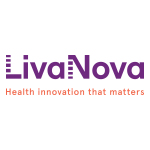LivaNova to Present New Data on Vagus Nerve Stimulation Therapy System at the American Epilepsy Society 2019 Annual Meeting

LONDON–(BUSINESS WIRE)–$LIVN–LivaNova PLC (NASDAQ:LIVN), a market-leading medical technology and innovation company, today announced it will present new registry data from two patient populations benefiting from Vagus Nerve Stimulation Therapy® (VNS Therapy) at the American Epilepsy Society 2019 Annual Meeting, December 6-10 in Baltimore, Maryland.
The first presentation is a sub-analysis of stimulation parameters that can determine the efficacy of VNS Therapy in patients with super-refractory status epilepticus (SRSE). SRSE is a type of refractory status epilepticus that continues despite 48 hours of anesthetic therapy and has high mortality and morbidity rates.1,2,3
Data on the seizure burden in patients with Lennox-Gastaut Syndrome (LGS) who later undergo VNS Therapy implantation will also be presented. LGS is a rare type of epilepsy with different types of seizures that can be hard to control and typically starts in childhood.4
“Our VNS Therapy System has successfully treated more than 100,000 patients around the world,” said Edward Andrle, LivaNova General Manager of Neuromodulation. “It is important to examine the clinical utility of VNS Therapy in different subgroups of patients with epilepsy to further our understanding and broaden the application of this technology.”
The data will be displayed on posters December 9, 2019, with presenters available from 8 a.m. – 2 p.m. Eastern time in the poster area. They are labeled as follows:
“Stimulation Parameters in Acute Vagus Nerve Stimulation for Super Refractory Status Epilepticus”
Maxine Dibué-Adjei, Francesco Brigo, Takamichi Yamamoto, Eugen Trinka, Kristl Vonck
“Demographics and Seizure Burden in Patients with Lennox Gastaut Syndrome in the VNS Therapy Outcomes Registry”
Marcel A. Kamp, Teresa Greco, Jochem K.H. Spoor, Hans-Jakob Steiger, Maxine Dibué-Adjei
For more information about the VNS Therapy System, visit the LivaNova website.
Important Safety Information
About VNS Therapy® for Epilepsy
VNS Therapy is clinically proven safe and effective for the treatment of drug-resistant epilepsy for adults and children 4 years of age and older. VNS Therapy is designed to prevent seizures before they occur and stop them if they do. It is a unique treatment approach developed for people with drug-resistant epilepsy—a condition that affects one in three people with epilepsy. VNS Therapy has not been evaluated by FDA for use in SRSE or LGS patients specifically. For more information, visit VNSTherapy.com.
INTENDED USE / INDICATIONS – UNITED STATES
Epilepsy—The VNS Therapy System is indicated for use as an adjunctive therapy in reducing the frequency of seizures in patients 4 years of age and older with partial onset seizures that are refractory to antiepileptic medications.
Commonly reported side effects are hoarseness, shortness of breath, sore throat and coughing. Side effects typically occur during stimulation and decrease over time.
See full safety information at VNSTherapy.com/safety.
About LivaNova
LivaNova PLC is a global medical technology and innovation company built on nearly five decades of experience and a relentless commitment to provide hope for patients and their families through innovative medical technologies, delivering life-changing improvements for both the Head and Heart. Headquartered in London, LivaNova employs approximately 4,000 employees and has a presence in more than 100 countries for the benefit of patients, healthcare professionals and healthcare systems worldwide. LivaNova operates as two businesses: Cardiovascular and Neuromodulation, with operating headquarters in Mirandola (Italy) and Houston (U.S.), respectively.
For more information, please visit www.livanova.com.
Safe Harbor Statement
This news release contains “forward-looking statements” concerning our goals, beliefs, expectations, strategies, objectives, plans and underlying assumptions and other statements that are not necessarily based on historical facts. These statements include, but are not limited to, statements regarding and our approach to treating drug-resistant epilepsy using VNS Therapy. Actual results may differ materially from those indicated in our forward-looking statements as a result of various factors, including those factors set forth in Item 1A of our Annual Report on Form 10-K for the year ended December 31, 2018, as supplemented by any risk factors contained in our Quarterly Reports on Form 10-Q and our Current Reports on Form 8-K. We undertake no obligation to update the information contained in this press release to reflect subsequently occurring events or circumstances.
References
- Shorvon S. Super-refractory status epilepticus: an approach to therapy in this difficult clinical situation. Epilepsia 2011;52(Suppl 8):53e6. https://doi.org/10.1111/j.1528-1167.2011.03238.x.
- Shorvon S, Ferlisi M. The treatment of super-refractory status epilepticus: a critical review of available therapies and a clinical treatment protocol. Brain 2011;134(Pt 10):2802e18. https://doi.org/10.1093/brain/awr215.
- Kantanen AM, Reinikainen M, Parviainen I, Ruokonen E, Ala-Peijari M, Backlund T, et al. Incidence and mortality of super-refractory status epilepticus in adults. Epilepsy Behav 2015;49:131e4. https://doi.org/10.1016/j.yebeh.2015.04.065.
- Epilepsy Foundation. Lennox-Gastaut Syndrome (LGS). Accessed November 13, 2019.
Contacts
LivaNova PLC
Deanna Wilke, +1 (281) 727-2764
Director, Corporate Communications
Corporate.Communications@livanova.com

